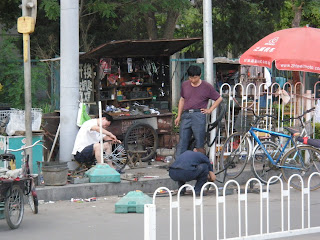 I've been away travelling in Xinjiang and South China visiting HIV/AIDS hospitals and volunteer groups, and so have not had a chance to write for some time. What I noticed was that the traffic is getting worse in all the 6 cities we visited, and it's also getting worse in Beijing.
I've been away travelling in Xinjiang and South China visiting HIV/AIDS hospitals and volunteer groups, and so have not had a chance to write for some time. What I noticed was that the traffic is getting worse in all the 6 cities we visited, and it's also getting worse in Beijing.
I look out of my window and can see traffic jams such as these everyday during peak hours.
If I look out another window to the 2nd Ring Road, it's not any better. By the way, the fogginess in the picture is not due to my camera!
The problem is that there are 20 million people in Beijing and 5 million cars. In 2010, 2,000 new cars were sold every day. Now the Beijing government has controlled this to 1000 new car licence plates issued every working day. On top of that, each car is not allowed on the roads one day per week, based on the car licence plate number.
And there are not just taxis, cars, buses, motor bikes, bikes and rickshaws on the roads, there are also tradesmen on every busy corner where they can do some business, such as this mini street market.

 The bus system is very good and cheap (less than 20 US cents), but also crowded. However, you need to speak Chinese to know where to get on and off.
The bus system is very good and cheap (less than 20 US cents), but also crowded. However, you need to speak Chinese to know where to get on and off.
There are even double decker buses, but they are just as crowded. Beware of thieves!
There is a big new transport hub built near my flat in Dongzhimen.
There are many buses that run from here, as well as the airport express close by and metro station.
 The metro only costs 2 RMB (around 30 US cents) for any distance. It is heavily subsidised by the local government to encourage people off the roads. Even though more and more lines are being built, they are insufficient, and getting a train needs a lot of patient queuing and/or pushing to get on! A record 7.6 million passengers - equivalent to the whole population of London - were carried in just one day in September this year! There are already around 350 km of lines in operation, about the same as in New York, and mostly built in the last 10 yrs.
The metro only costs 2 RMB (around 30 US cents) for any distance. It is heavily subsidised by the local government to encourage people off the roads. Even though more and more lines are being built, they are insufficient, and getting a train needs a lot of patient queuing and/or pushing to get on! A record 7.6 million passengers - equivalent to the whole population of London - were carried in just one day in September this year! There are already around 350 km of lines in operation, about the same as in New York, and mostly built in the last 10 yrs.  Just outside the shiny new buildings, there are also rickshaws available. Remember to bargain with them or you will be ripped off. They are especially welcome during rush hour when taxis are very hard to find. Taxis are cheap compared to the West, around 2 RMB per km.
Just outside the shiny new buildings, there are also rickshaws available. Remember to bargain with them or you will be ripped off. They are especially welcome during rush hour when taxis are very hard to find. Taxis are cheap compared to the West, around 2 RMB per km.
There is also a long distance bus station next to the transport hub, and you can take a bus trip to Jinshanling which is one of the most spectacular parts of the Great Wall, or to Panshan, a mountain area a few hours drive away.
Motor bikes are restricted, but you can still see many of them in this parking area.
I prefer to cycle around when I can. You feel so free and happy when you can go faster than all the cars stuck in the traffic. There are many small roads with trees on both sides which are cool in summer. Cycling down the hutongs to see the local life is also interesting. There are bicycle parks to keep your bike safe. However, theft is not so much of a problem now. I think the thieves focus on mobile phones, iPads and laptops these days.
If you get a puncture or need some repair work done, then it's quite easy to find a bike repair man.
And I think it's so romantic to take your girl (or boy) friend on the back of your bike, something you don't see much of these days.
Note how the cars are going down the wrong way on a one way street.
You can do it even in broad daylight and get away with it!


















No comments:
Post a Comment